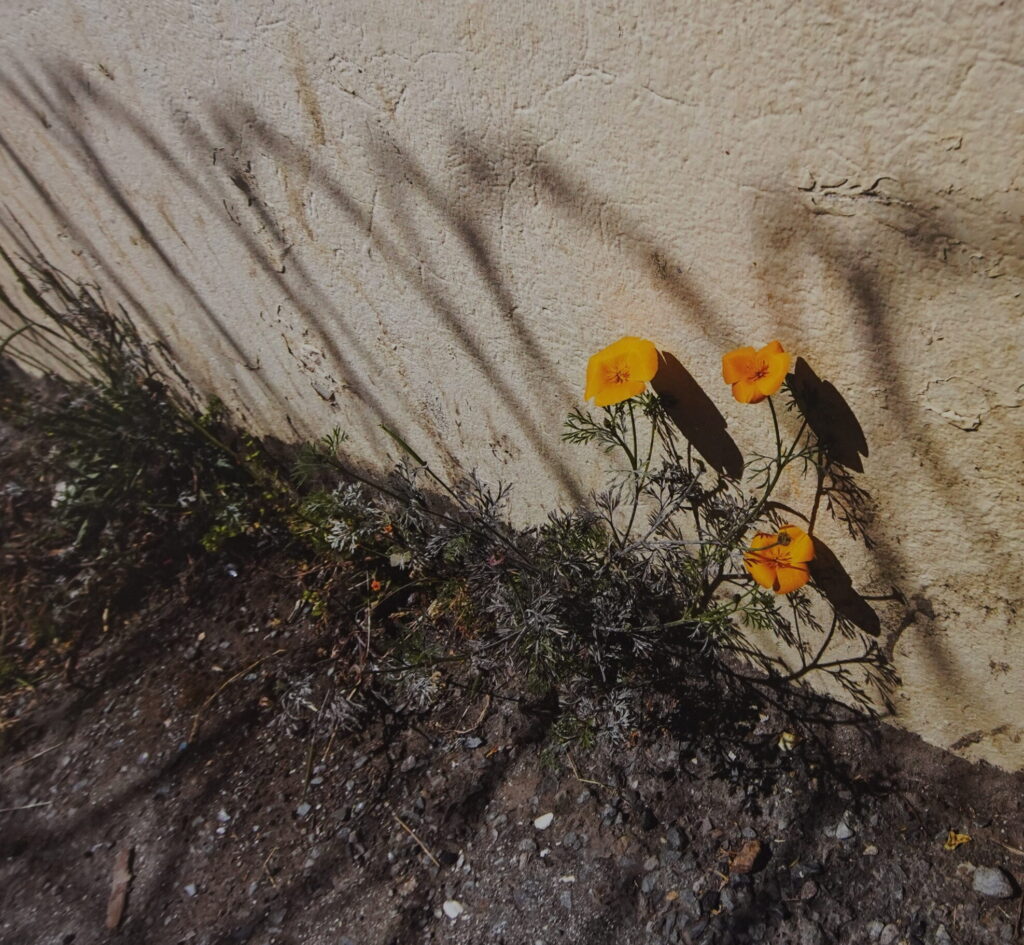
Every spring they appear at San Quentin Rehabilitation Center (SQRC), these small surges of delicate orange. They break through cracks in the asphalt. They creep along the sides of the media center and burst into bushier bloom around the prison’s education bungalow.
The California Poppy is a common enough sight along the state’s countless freeways. Still for us — one former San Quentin News editor-in-chief (Jesse), and one long-time media center volunteer (Kate) — the plant’s annual appearance inside the state prison remains a constant source of wonder. We marvel at the poppy’s beauty, spontaneity, and boundlessness, even in inhospitable places.
And as we reimagined Wall City magazine over the last few years, this flower kept springing to mind.
The publication was born from the San Quentin News in 2018, where the staff sought, in the words of the magazine’s founding editor Arnulfo Garcia, to “tell important stories with more space and creative freedom” than is possible in a newspaper. Wall City met these aspirations and then some. But it was limited by the print format and by the newspaper’s coverage area. SQRC, after all, only holds about 3% of California’s prison population.
We began to question those limitations in 2023, as the newspaper’s outside arm Friends of San Quentin News developed into the Pollen Initiative, with a mandate to cultivate media centers in other prisons. We asked ourselves: could we grow not just in number but also in creativity? Not just by seed, but also by flower?
This digital reboot is our answer to those questions. We are expanding Wall City as a digital-first magazine to include a wider range of documentary arts, across media, by contributors all around California.
This state-wide focus will help fill a much needed gap in our understanding about California’s role in the creation of mass incarceration. It’s likely no surprise to readers that our state has left an outsized imprint on U.S. criminal legal policy. Scholars like UCLA Professor of History Kelly Lytle Hernández have chronicled California’s leading role throughout the 20th century in criminalizing race, especially in Los Angeles. In the 1990s, the state enacted the first “Three Strikes” law. In the 2000s, it continued the pattern of extreme sentencing through gun enhancements and gang injunctions. As a result, the prison population ballooned from 25,000 in 1970 to its peak of approximately 173,000 in 2006. Today, the state still holds the country’s largest number of prisons (31 adult institutions) and largest in-prison population (91,170 people).
…what if we could grow, not just in number but also in creativity? Not just by seed, but also by flower?
How we got here is a story specific to California — its borderlands, its shifting demographics, its drug trade, its gangs and gang culture. And it’s a story that cannot be understood in its fullness unless we highlight just how varied the experience of incarceration across the California Department of Corrections and Rehabilitation (CDCR) has been, and still can be.
Jesse, who did almost 20 years across 12 facilities, often reminds us that both CDCR administrative policies and prison culture evolved in response to the prison population’s rise. Often in significant tension with each other. Wall City aims to tell stories about these changes and their impact, from the use of Security Housing Units (SHU) for indeterminate lengths of time for validated prison gang members (Pelican Bay State Prison, California Correctional Institution,Tehachapi, and California State Prison, Corcoran) to the spread of the Sensitive Needs Yard (SNY) and Non-Designated Programming Facilities (NDPFs) all across the state.
Legacy prison gangs, and newer ones on the SNY, still vie for power and space. But the reintegration of previously separated groups has also created new factions and new social norms. Many incarcerated individuals have seized the moment to recreate their facilities with hope in mind.
We saw this most clearly illustrated in a recent visit to Pelican Bay, home of the state’s most infamous SHU, where the catacombs-like “short corridor” has been transformed by murals that include a life-like aquarium. The former dreary silence has been drowned out by friendly chatter over cups of hazelnut flavored coffee. The clink of keys now signals an approaching tour rather than the threat of being hauled away. Similar changes are underway in places like Salinas Valley State Prison, a maximum security facility where residents and staff have recently repurposed state computers in order to broaden educational opportunities for residents with learning difficulties.
We want to track this kaleidoscope of incremental changes, parts of a surging state-wide interest to imagine something better, what Sacramento aspirationally calls the “California Model” of prison reform. We also want to make visible the countless individual persons, places and things— often small but still profound— that create community.
We recognize that such extremes can coexist in the same space. But to capture these apparent contradictions, we need a bigger documentary toolbox. That’s why Wall City invites submissions in text, visual and audio format across a wide range of non-fiction forms: reported and first-person essays, oral histories, as-told-to stories and profiles, dispatches and reviews, comics and still-lifes and data visualizations.
Through this creative mix, we hope to encourage conversations about our carceral system that are deeper, textured, nuanced, insightful, even inflected with the sort of humor that can come from clarity—and ultimately to let a thousand flowers bloom in these cities of concrete.
Kate McQueen is editorial director at Pollen Initiative.
Jesse Vasquez is executive director at Pollen Initiative.

From my window I look out at a Minnesota snow covered landscape and give thanks that I have a home that is protecting me from the -30 wind chill that is functioning as an environmental “lock down.” Then, I read the news and shudder at the cold-hearted actions that are keeping millions of people in an emotional “lock down.” Then I get a reminder that spring will come, even in dark and cold times. And coming from an unlikely place – San Quentin.